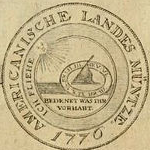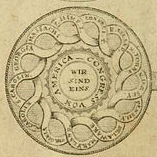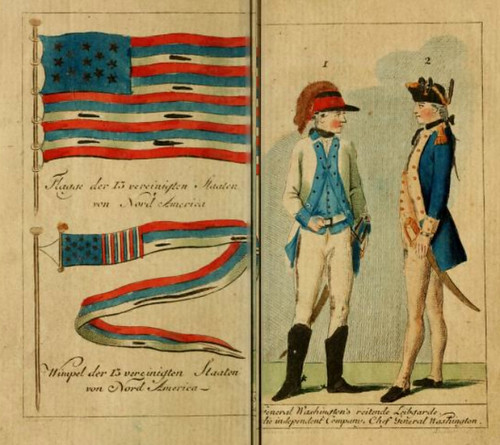
PREV ARTICLE
NEXT ARTICLE
FULL ISSUE
PREV FULL ISSUE
MORE ON THE ORIGINS OF THE CONTINENTAL DOLLARReaders continue to ferret out threads of information on the origin of the Continental Dollars. First up is Tom Wetter. -Editor
German Inscriptions in Book Illustration   Before someone goes off track and chases a red-herring, be aware that the coin pictured in Allgemeines does not exist. That fact is made in the text, on page 180: "Damit die Innschriften gleign volle Wirs fung thun mochten, sind fie, zum Behuf des Deutschen Lesers, übersetzt eingetragen." That means: "In order that the inscriptions might have full effect, they are, for the sake of the German reader, translated." I mentioned that last week, but it's important to note. Thanks for the translation. -Editor
If I were researching this, I would not look to London. I have a hard time accepting the fact that anything such as this would be possible in London while we were in the middle of our Revolutionary War with England and also given the fact that all communication was by boat. 26 May 1783 Letter to Franklin Tom cited a May 26, 1783, letter from Charles Spener. The letter is written in French. Here is a rough machine translation to English via Google Translate, with a few minor edits by
me and Len Augsburger. Could anyone supply a more faithful translation? -Editor
Berlin on 26 May 1783. Sir. With the intention of publishing, towards the end of September, an American Almanac in German for the coming year, and desiring to decorate it with several related prints, the composition of which should not be ideal; it is to you, Sir, and to your wallet, that must be very rich in all that relates to the history of the Anglo-American Colonies which I dare to resort to, although I do not have the honor of You to be known. Let me briefly describe the plan of this Almanac, and then ask for your gracious assistance, either for information or for the very articles I need, and that no one is better off to provide me that You Sir! Almanac will contain, in the first place, the history of the Revolution, according to the best Authors and the most veridical opinions which may have been obtained. This subject will be adorned with historical engravings, representing the most remarkable events of this war. In the second place: Gallery of the great men of America, with an account of their political or military career decorated with their portraits, copied from those drawn by Du Simitier at Philadelphia, and others which have appeared in England. Come You hold such a high rank among the great men of America, suffer that I ask you, if your portrait, as it was engraved in 1782 by Pelicier for the Essay on the Anglo-Americans, is enough resembling to serve as a model? To make this gallery more complete, I would pass from great men to the celebrated men of America, and this is where I am in trouble for the following portraits: John Adams's picture To these portraits I would like to be able to join the following pieces: Mausoleum ordered by Congress to Dr. Warren. Medal struck by order of Congress on the occasion of the Form of the Pappier-monnoye The historical part of this Almanac being entrusted to one of our best historians, Sr. Sprengel, Professor of History at the University of Halle, who possesses the English and all the knowledge and qualities which constitute the good historian, I venture to flatter myself, that his work will deserve your approval. I therefore reserve to myself the honor of presenting him to you, and even through your mediation to the honorable Members of Congress, to whom I wish to pay tribute. Forgive me, sir, in favor of this idea, that I may interrupt Your grave occupations by a hors d'oeuvre of this kind, and grant me the grace of deferring to my very humble request. Finally, allow me to add, that the time here, at the end of September, which is fixed for the publication of the Almanacs of our country, is scarcely distant, and the execution of the various engravings requiring considerable time, furnishing as much as possible the materials which are wanting to me, you will add infinitely to the price of the benefit I am soliciting. Bis dat, which cito dat. May it be lawful for me to show you here the veneration and respect most warmly felt, of which I am penetrated for the Philosopher and the statesman, that the two hemispheres in You! It is in these sentiments that I have the honor to be Monsieur Your very submissive and obedient Charles Spener To read the complete letter, see: The published book (at least the one imaged for the Newman Portal) only has a few of the planned illustrations, but the American flag and others are included, some in color.
-Editor
  Sarah Banks Catalogue Advertisement Bob Leonard submitted these notes on Catherine Eagleton's 2015 Numismatic Chronicle article. Thanks! -Editor
I'm a little surprised that no one has yet mentioned the paper by Catherine Eagleton published in The Numismatic Chronicle for 2014, "Collecting America: Sarah Sophia Banks and the 'Continental Dollar' of 1776," pp. 293-301. Ms. Eagleton argues "that the piece may never have been intended as a coin at all, not struck in America, or even made in 1776." She bases her conclusion on the catalog of the Sarah Sophia Banks collection, now in the British Museum: in the 1815 version of this catalog, following the entry for "Congress Dollar. 1776. never current, struck on speculation in Europe, for sale in America" appears an advertisement pasted in the catalog after the entry: Six-Pence Each. N. B. Representing the Paper Currency of a Dollar, which goes for E X P L A N A T I O N. The Thirteen Colonies united like a Chain, with the names of each The Reverfe is the Sun going round its Orbit, with a Motto The Letters, E. G, FECIT, its maker's Name. Ms. Eagleton did not have the benefit of Eric P. Newman and Maureen Levine's article "18th-Century Writings on the Continental Currency Dollar Coin," The Numismatist July 2014, pp. 34-57, because she mentions "contemporary references confirming that the Continental Dollar was made before 1786" (p. 299). In fact, as Eric and Maureen have pointed out, crediting me for the discovery, the Continental Dollar was mentioned in a poem published in New York November 6, 1779 and illustrated as early as 1784. The advertisement is new to me, however. My own opinion (as of now) is that the Continental Dollars were originally coined in 1776-78 as speculative patterns in the hope of obtaining a coinage contract, but the effort died, the Continental Congress never going so far as even to appoint a committee to study the matter. But it has always seemed as though there are too many of them around in uncirculated condition for this purpose, and it would now appear that some dies were taken to England after the Revolution (the Continental Dollar is listed in a catalog of the Banks collection made "in or before 1790") and copies restruck there. (Note: the omission of the dollar denomination from the paper money emission of July 22, 1776, continuing to January 14, 1779, is NOT evidence that the Continental Dollar was intended to fill the gap; there was already a dollar coin in circulation, the Spanish Milled Dollar.) It seems clear to me that at least SOME "1776" Continental Dollars were struck in London in 1783; this fits well with Du Simitiere's statement and the first illustration in 1783, plus the Banks Collection example. Rivington’s Gazette Poem, Nov. 6, 1779 Bob discussed the poem in an October 21, 2012 E-Sylum article, linked below. Tom Wetter notes that the poem from New York's Rivington's Royal Gazette on Nov. 7,
1779 that Bob mentioned is now available online. Here's the relevant excerpt. -Editor
Congress will nobly pay him for his pains, Tom Wetter adds: it doesn't say continental dollars, it says pewter dollars. Reading back through it I don't think it's very applicable here. I have a book from 1769 with a similar reference to 'pewter dollars' and the only thing it does prove is that that term was in use before 1776, and, it could discredit that poem. The Congratulation (http://www.historycarper.com/1779/11/06/the-congratulation/) Thanks, everyone. These are more important clues on the origin of these enigmatic pieces. Franklin of course is "one of the usual suspects" in this era, so I'm not
surprised to learn of a new connection.
The advertisement describes the 1776 date as "the time they declared Independency." To me, this implies that 1776 was NOT the actual date they were struck; at least not the examples offered in this advert. Is that the earliest reference we're now aware of? Bob Leonard provided the following summary of events. -Editor 1. Du Simitiere wrote, in 1783 or 1784, that the Continental Dollar was "Struckt in London on Type-Metal, and dated 1776." (Orosz, pp. 26-7) 2. The earliest illustration of a Continental Dollar appears IN EUROPE in late 1783. 3. The Sarah Sophia Banks collection of London contained thousands of coins by 1791. Circa 1815, her Continental Dollar was cataloged as "Congress Dollar. 1776. never current, struck on speculation in Europe, for sale in America." An accompanying ad offers them for sixpence each, adding "The Date, 1776, is the time they declared Independency. The Letters E. G. Fecit, its makers Name." 4. No record authorizing it has been found in the papers of the Continental Congress for 1776. 5. In Boston, the January 1, 1789 issue of the Independent Chronicle and the Universal Advertiser denied that there ever was such a coin as the Continental Dollar. Likewise, on February 21, 1790, Paul Revere wrote, "as for pewter money struck in America, I never saw any, and I have made carefull (sic) inquiry" (both citations from Newman and Levine, p. 50). Were this any other coin, we would have no hesitation in attributing it to European speculators in 1783, a time when a U.S. coinage was being seriously considered (the Nova Constellatio coppers were issued that year). Against this attribution is the reference in the satirical 1779 poem to Congress paying "pewter dollars," but perhaps this should not be taken literally. Also, in 1911, Gallaudet family historian Edward Miner Gallaudet informed a relative that EG FECIT stood for 18th-century New York engraver Elisha Gallaudet (Newman and Levine pp. 51-2). While Elisha Gallaudet is chronologically possible for 1783 as well as 1776, and the Continental Dollar dies COULD have been engraved in New York for striking in London, he offered no evidence and this could merely be wishful thinking. Engravers with the initials E G should be looked for in England.  To read the earlier E-Sylum articles, see:  Wayne Homren, Editor The Numismatic Bibliomania Society is a non-profit organization promoting numismatic literature. See our web site at coinbooks.org. To submit items for publication in The E-Sylum, write to the Editor at this address: whomren@gmail.com To subscribe go to: https://my.binhost.com/lists/listinfo/esylum All Rights Reserved. NBS Home Page Contact the NBS webmaster 
|